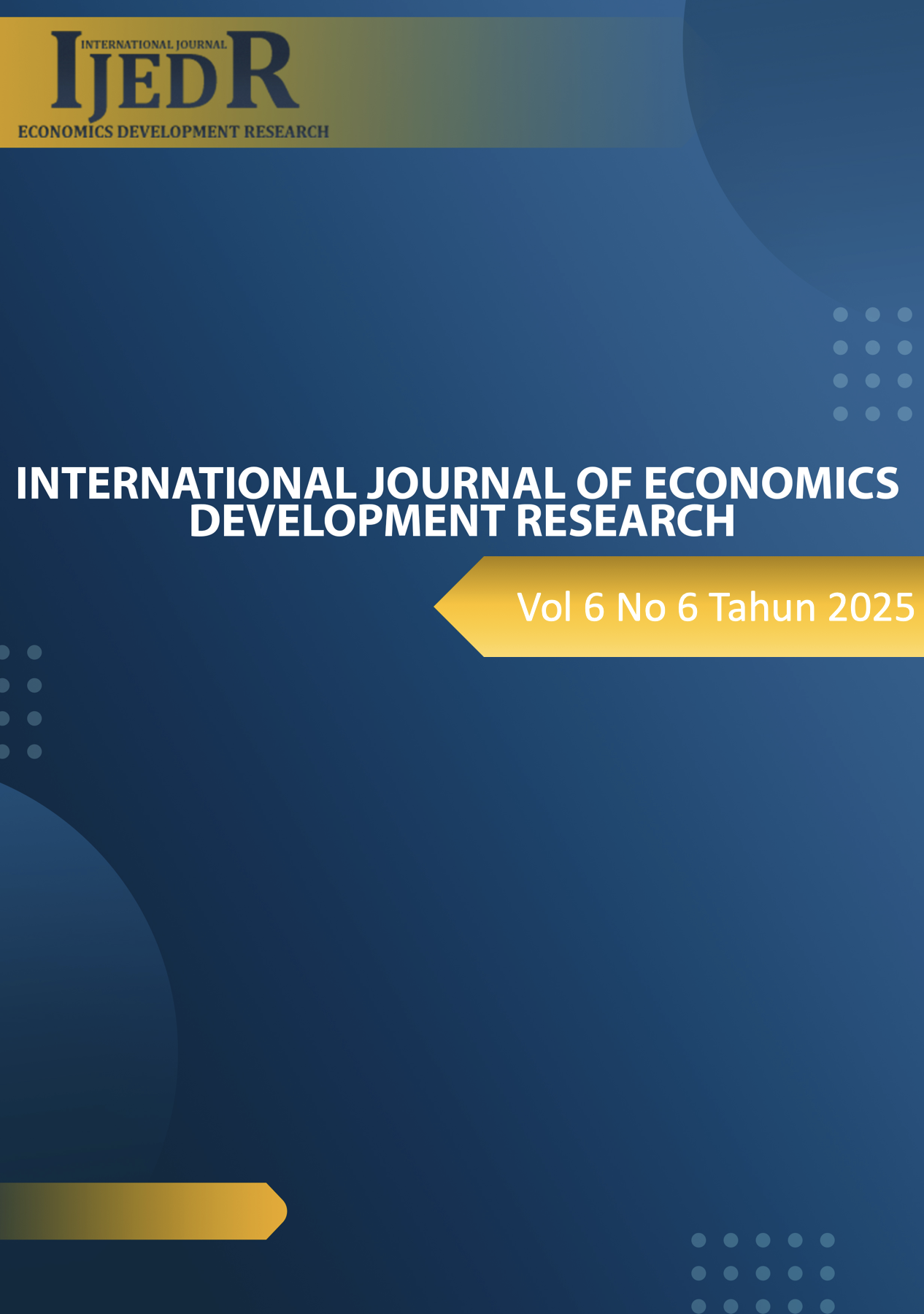Resolving Conflicts, Sustaining Livelihoods: A Fisheries Resource Management Model for Enhancing Fishermen’s Welfare
DOI:
https://doi.org/10.37385/ijedr.v6i6.9280Keywords:
Fishermen, Welfare, Management, Capture Fisheries, ResolutionAbstract
This study aims to analyse the effect of capture fisheries resources and conflict resolution on fishermen's welfare in the coastal area of Sibolga City, as well as to explore the moderating role of conflict resolution in the relationship between capture fisheries resources and fishermen's welfare. The study used a quantitative approach with data collection through questionnaires administered to active fishermen in coastal areas, and analysed using linear regression and moderation tests. The results showed that capture fisheries resources and conflict resolution had a significant effect on fishermen's welfare, but conflict resolution did not act as a moderating variable between capture fisheries resources and fishermen's welfare. These findings emphasise the importance of effective fisheries resource management and conflict resolution strategies as efforts to improve fishermen's welfare. This study has implications for the government and related institutions to strengthen fisheries resource management, improve conflict resolution capacity, and design sustainable development programmes that support the welfare of coastal communities.
References
Arceo, H. (2021). Capture fisheries resources in the West Philippine Sea (WPS): Is it worth fighting for? Presentation to a special session on the West.
Bambang, A. N., & Triarso, I. (2020). Excellent commodity of capture fisheries and preservation of fish resources in Pekalongan City. E3S Web of Conferences, 62, Article 06042. https://www.e3s-conferences.org/articles/e3sconf/abs/2020/62/e3sconf_icenis2020_06042/e3sconf_icenis2020_06042.html
Bidayani, E., & Kurniawan, K. (2023). Efficiency of small-scale capture fisheries in conflict areas of Bangka Regency. Sosial Ekonomi Kelautan dan Perikanan, 18(1), 51–66. Retrieved from https://ejournal-balitbang.kkp.go.id/index.php/sosek/article/view/11767
Chakraborty, A. (2023). Freshwater blues: The scarcity of freshwater fish resources in the eastern Indian state of West Bengal highlights alarming trends in inland capture fisheries. Samudra Report. Retrieved from http://icsfarchives.net/20145/
Daris, L., Massiseng, A. N. A., Fachri, M. E., & Mustaking, M. (2023). The role of local community institutions in managing capture fisheries resources in the coastal areas of Maros Regency. Agrikan Journal. Retrieved from https://ejournal.stipwunaraha.ac.id/AGRIKAN/article/view/651
Daris, L., Massiseng, A. N. A., Fachri, M. E., Jaya, & Mustaking, M. (2024). The role of women in conflict resolution on the utilisation of capture fisheries resources in the coastal area of South Sulawesi. Journal of Sustainability Science and Management, 19(9), 20–34. https://doi.org/10.46754/jssm.2024.09.002
Dewi, K., & Prasetyo, A. (2022). The role of fishing institutions in conflict resolution and welfare improvement. Journal of Coastal Management, 9(1), 55–67.
Fajri, N. E. (2021). Capture fishery management status through the ecosystem approach on fish resources domain in Sungai Apit sub-district, Siak district. AACL Bioflux, 14(3), 1308–1316.
Fesanrey, W., & Tuhulola, E. (2022). Analisis tingkat kesejahteraan masyarakat nelayan di Desa Bara (Analysis of welfare level of fishermen community). Uniqbu Journal of Exact Sciences, 3(2), 8–16. https://doi.org/10.47323/ujes.v3i2.226
Kusumaningrum, A., Lumingas, L. L. J., & Sumilat, D. A. (2021). Analysis of leading commodities from capture fisheries resources at Bitung Oceanic Fishing Port, North Sulawesi. JASM (Journal of Aquatic Science & Management), 9(2), 1-10. https://doi.org/10.35800/jasm.v9i2.35130
Li G, Zhang W, Qiu H, Tan C, Niu J (2024) The allocation of carbon resources in marine capture fisheries. PLoS ONE 19(3): e0293120. https://doi.org/10.1371/journal.pone.0293120
Mardyani, Y., Bidayani, E., Kurniawan, S. A., & Setiawan, F. (2023). Small-scale fisheries efficiency in conflict areas in Bangka Regency. Jurnal Sosial Ekonomi Kelautan dan Perikanan. 18(1), 51-66. http://dx.doi.org/10.15578/jsekp.v18i1.11767
Nisari, T., Siburian, J. P., Harahap, H. Y., & T. A. (2024). Socio-economic study of Bagan Tancap fisheries in Muara Nibung Village, Central Tapanuli Regency. Journal of Fisheries Economics, 3(5), 208–213.
Nuraini, S., Hakim, L., & Siregar, A. (2021). Degradation of fishery resources and its impact on the welfare of coastal fishermen. Marine Policy Journal, 18(1), 33–45.
Nurhayati, A., Herawati, T., Lili, W., Yustiati, A., & Nurruhwati Matindas, I. (2020). Enviromental Socio-Economic Value for Capture Fisheries Resources at Jatigede Reservoir, Sumedang, West Java Province. Jurnal Penyuluhan, 16(1), 122-133. https://doi.org/10.25015/16202025262
Camarero Orive, A., González-Cancelas, N., Vaca Cabrero, J., & Parra Santiago, J. I. (2022). Use of a Delphi Panel to Determine the Degree of Implementation of Blue Economy in Spanish Ports. Journal of Marine Science and Engineering, 10(11), 1573. https://doi.org/10.3390/jmse10111573
Pramono, B., Utami, R., & Lestari, D. (2021). Analysis of the role of conflict resolution in the economic sustainability of fishermen. Journal of Coastal and Ocean Studies, 26(4), 289–302.
Prana, U. G., Lubis, I. T., Akasah, W., Caraka, R. E., et al. (2022). Partial least squares structural equation modelling (PLS-SEM) with WarpPLS software. Uwais Inspirasi Indonesia.
Rath, S. (2023). Blue-green nature-based solutions for urban wastewater: Enabling a circular economy. Urban Architecture and Construction, 14(2), 147–162.
Sawestri, S. (2021). Capture fishery resources of Citanduy River, West Java. IOP Conference Series: Earth and Environmental Science, 934.
Selawaty, D., Windiarti, I. S., & Ashari, M. (2020). Strategi Pemerintah Daerah Dalam Mempertahankan Sumber Daya Perikanan Tangkap Di Sungai Rungan Kota Palangka Raya Kalimantan Tengah: Local Government Strategy In Maintaining Capture Fisheries Resources In River Rungan, Palangka City, Central Kalimantan. Anterior Jurnal, 20(1), 108–122. https://doi.org/10.33084/anterior.v20i1.1532
Simanjuntak, R., & Purwanto, D. (2020). The influence of fishery resource availability on the income of traditional fishermen. Journal of Marine and Fisheries Social Economics, 15(2), 145–156.
Sugiyono. (2018). Quantitative and qualitative research methods. Bandung: Alfabeta.
Suryana, A. A. H., & Perdiansyah. (2021). Analysis of human resources competitiveness of capture fisheries in Indonesia. Asian Journal of Fisheries and Aquatic Research, 15(2), 40–46. https://doi.org/10.9734/ajfar/2021/v15i230326
Sari, D., & Hidayat, F. (2020). Ecological and social factors in determining fisher household income. Journal of Development Economics, 21(2), 99–110.
Yusuf, M., Abdullah, R., & Fahmi, I. (2019). Community-based conflict resolution in the management of fishing areas. Jurnal Kelautan Nusantara, 12(3), 201–212.





